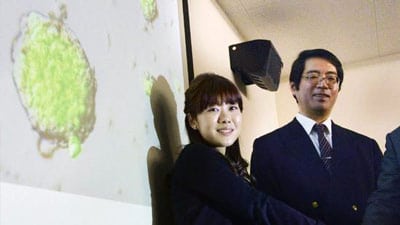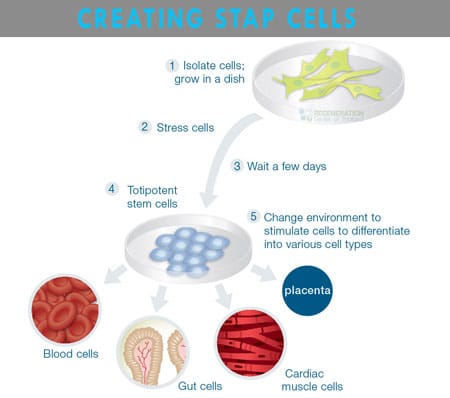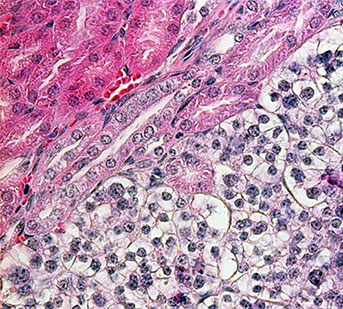Science is a tribute to what we can know although we are fallible. – Jacob Bronowski
Biologist Dr Haruko Obokata of the RIKEN institute in Kobe Japan has been unable to reproduce pluripotent results from a controversial “Acid Bath” technique involving mice derived adult stem cells. The technique was coined STAP or “stimulus-triggered acquisition of pluripotency” and made international headlines earlier in 2014 with a stunningly simple method of reverting cells to Pluripotency.[3] STAP cells should be able to differentiate themselves into placental cell stage which would make even more useful (clinically) as embryonic cells or even iPS cells (induced pluripotent stemcells) which were previously thought to be the most powerful cell types due to their abilities to transform themselves into nearly every cell type in the human body.[2] The value of such cells in regenerative medicine would be unimaginable.
Martin and Charles Vacanti first hypothesized STAP cells and spontaneous pluripotency in 2003. Dr Obokata learned about STAP cells while studying under Dr. Charles Vacanti at Harvard Medical School.

A breakthrough was first noted by Dr Yoshiki Sasai and Obokata in 2013 through their experiments that subjected adult stem cells to extremely stressful environments, such as bacterial toxins,extreme physical pressure through the use of capillary tubes and exposing the common cells to mild acidic bath. [1] The cells were then engineered to glow fluorescent green to express the genes that are prevalent in pluripotent cells. The research papers that Dr Obokata co-authored were published in the Journal “Nature” in January of 2014 rapidly gaining worldwide headlines.
Many scientists in the international community quickly attacked the credibility of the findings by claiming the images were digitally enhanced and perhaps not authentic. Upon further investigation, the RIKEN centre found evidence of scientific misconduct, resulting in a retraction of the published paper. Upon the retraction of the paper, the co-author, Dr Yoshiki Sasai, committed suicide at the RIKEN Institute.
The RIKEN institute allowed the remaining author ( Dr Haruko) three months (until the end of November 2014) to reproduce the results and validate the original findings.

After rigorous testing of the technique, the results could not be replicated. The scientists even tried to introduce the STAP cells to a mouse embryo to see if they would contribute to the creation of various tissues but were unsuccessful in their findings.
On Dec 19th 2014, Dr Haruko Obokata resigned from her position at the RIKEN Center and posted her resignation letter on RIKEN’s website along with the results from the organization’s’ internal investigation.
In the end, the systematic methodology of science did what it is supposed to do. Scientists and researchers create experiments and then conduct trials. If their results are interesting, they get published in the public realm. Since the results are now public, other scientists and researchers can/should try to reproduce the findings to verify their authenticity. If the subsequent results are verified independently they become stronger, however if the results cannot be replicated, the findings were incorrect and there must have been a mistake somewhere in the process.
Unfortunately, in today’s world, the media and press try to label all findings as scientific truth without realizing that even published papers can be incorrect at times in our eternal pursuit of biological answers.
Published Clinical Citations
[1] ^ Obokata, Haruko, Teruhiko Wakayama, Yoshiki Sasai, Koji Kojima, Martin P Vacanti, Hitoshi Niwa, Masayuki Yamato, and Charles A Vacanti. 2014. Stimulus-triggered fate conversion of somatic cells into pluripotency. Nature, no. 7485 ( 30). doi:10.1038/nature12968. https://www.ncbi.nlm.nih.gov/pubmed/24476887
[2] ^ Pera, Martin F. 2014. Stress management: a new path to pluripotency. Cell stem cell, no. 3 ( 6). doi:10.1016/j.stem.2014.02.009. https://www.ncbi.nlm.nih.gov/pubmed/24607402
[3] ^ Obokata, Haruko, Yoshiki Sasai, Hitoshi Niwa, Mitsutaka Kadota, Munazah Andrabi, Nozomu Takata, Mikiko Tokoro, et al. 2014. Bidirectional developmental potential in reprogrammed cells with acquired pluripotency. Nature, no. 7485 ( 30). doi:10.1038/nature12969. https://www.ncbi.nlm.nih.gov/pubmed/24476891

